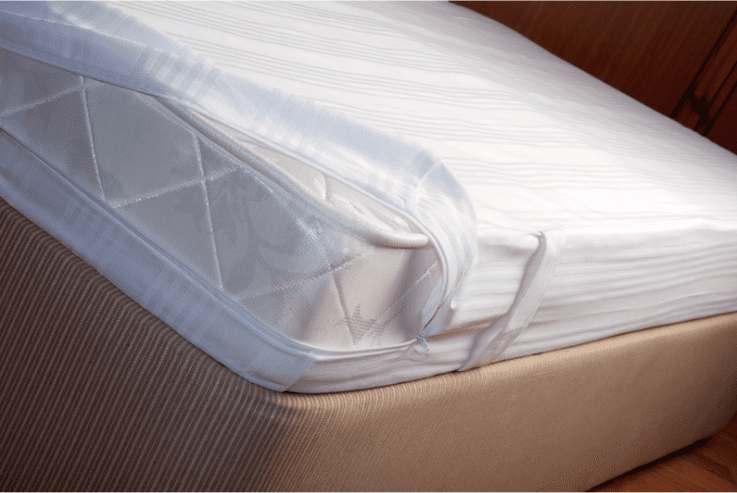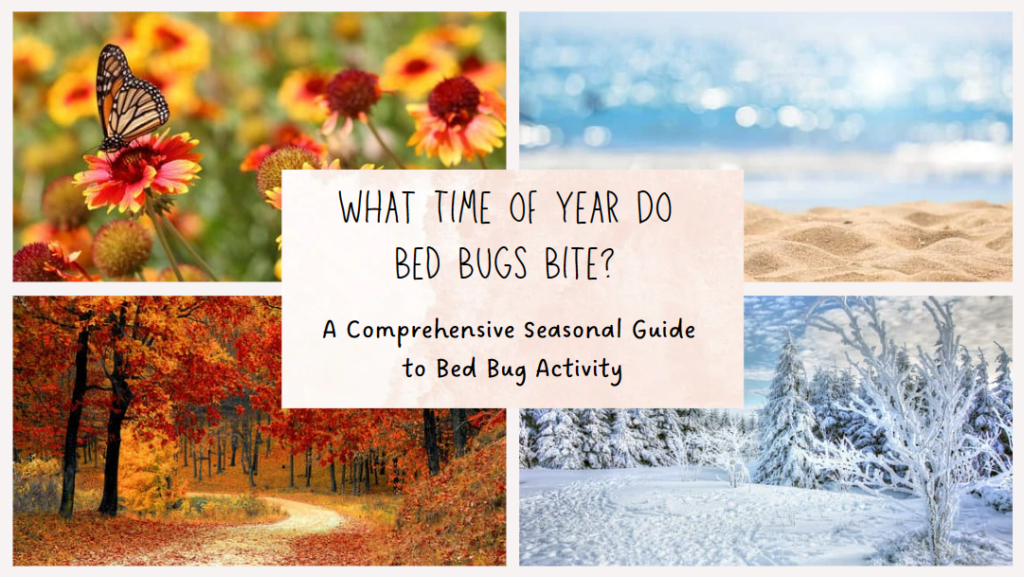Introduction
Understanding bed bug behavior across different seasons is paramount to implementing effective prevention and treatment strategies. Contrary to popular belief, these persistent pests don’t simply vanish or become inactive during certain times of the year; they adapt. The objective of this guide is to shed light on what time of the year bed bugs bite, providing you with essential insights to not just combat but prevent bed bug bites throughout the year.
Many people mistakenly think that bed bug concerns are limited to specific seasons, particularly the warmer months. This misconception can leave you vulnerable to bed bug infestations when you least expect them. To protect yourself and your loved ones, it’s crucial to be informed about how bed bug activity ebbs and flows with the changing seasons. In collaboration with entomologists and pest control experts, we’ve compiled a detailed seasonal guide that will serve as your year-round resource for understanding when and why bed bugs bite.
According to a study published by the Journal of Medical Entomology, bed bugs can survive and remain active at temperatures as low as 46°F. This underscores the need for vigilance in all seasons, not just the summer months.
By understanding the seasonal patterns of bed bug behavior, you can take targeted preventive measures, recognize infestations early, and act swiftly to eradicate these pests from your living space. Stay with us as we debunk myths, analyze seasonal trends, and provide expert tips on keeping your home bed bug-free year-round.
Common Myths About Bed Bug Seasonality
One of the most significant obstacles to effective bed bug control is the circulation of myths and misconceptions. This section aims to debunk some of the most pervasive myths surrounding the seasonality of bed bugs. By doing so, we lay the groundwork for understanding the evidence-based realities what time of the year bed bugs bite.
Debunking the Myth that Bed Bugs are Only a Summertime Problem

Many people harbor the false belief that bed bugs are a “summertime problem.” Thinking that these pests hibernate or die off in the colder months. This misconception can lead to lax prevention measures in winter, spring, and fall, making households more susceptible to infestations. According to a comprehensive study in the Journal of Economic Entomology, bed bugs exhibit consistent feeding patterns across varied temperatures, challenging the notion that they are solely summertime pests.
Addressing Misconceptions About What Time of the Year do Bed Bugs Bite
Another widespread myth is that bed bugs enter a state of dormancy during the winter, similar to some other insects. While it’s true that bed bugs are less active in colder temperatures, they do not hibernate. In fact, indoor heating can provide an optimal environment for bed bugs to thrive during winter months. A from the Journal of Medical Entomology states that bed bugs can remain active even at temperatures as low as 46°F, revealing the need for year-round vigilance.
Armed with the truth about these myths, we can now dive deeper into the science-backed realities of bed bug behavior across different seasons, offering you the knowledge needed to take targeted and effective preventive measures throughout the year.
Seasonal Patterns of Bed Bug Activity
Understanding the seasonal patterns of bed bug activity is critical for effective prevention and treatment. This section offers an in-depth look at how bed bugs adapt and behave during each season, providing you with the data-driven insights you need to stay ahead of these pesky invaders.
Spring
As winter subsides and temperatures rise, bed bugs come out of their semi-hibernative state. While they don’t truly hibernate, cooler temperatures can make them less active. With the onset of spring, they become more energetic, feeding and breeding with renewed vigor. Spring cleaning offers an excellent opportunity to inspect your home for signs of an infestation, such as eggs, fecal spots, and live bugs. According to research published in the Journal of Thermal Biology, the optimal temperature for bed bug activity is between 70°F and 80°F [Source], which makes spring an active season for these pests.
Summer
Summer is often considered the peak season for bed bug activity, but not solely for climatic reasons. The increase in human travel during these months can significantly contribute to the spread of bed bugs. Hotels, motels, and short-term rentals often become hotspots for infestations. A study in the Journal of Economic Entomology emphasizes the role of human movement in the proliferation of bed bugs. Therefore, summertime requires extra vigilance, especially if you’re staying in temporary accommodations.
Fall
As temperatures begin to drop, bed bugs prepare for the colder months. Contrary to popular belief, they don’t die off or go into hibernation. Fall is also the time when students return to school, and dormitories can become breeding grounds for bed bugs. Campus housing staff and students alike should take proactive measures to prevent the spread of these pests.
Winter
Many people think winter eliminates the bed bug problem, but this is far from the truth. Indoor heating systems offer a conducive environment for bed bugs to remain active. As mentioned earlier, bed bugs can even sustain activity at temperatures as low as 46°F. During winter, focus on prevention strategies like regular inspections and early treatments to ensure a bed bug-free home.
In summary, bed bugs adapt to different seasons in various ways, requiring you to adjust your prevention and treatment tactics accordingly. With this knowledge in hand, you’re better equipped to combat these persistent pests all year long.
Seasonal Prevention Strategies
Armed with a thorough understanding of bed bug behavior across the year, you’re now prepared to delve into preventive measures tailored to each season. Implementing these strategies can drastically reduce the risk of experiencing a bed bug infestation, offering you and your family much-needed peace of mind. Keep in mind that prevention is always better—and often cheaper—than treatment.
Spring & Summer
Spring and summer are active seasons for bed bugs, but they should also be active seasons for your prevention strategies. During these warmer months, the use of bed bug-proof mattress and pillow encasements is highly recommended. These create a physical barrier that bed bugs can neither penetrate nor escape from. Additionally, given the surge in travel activities, it’s crucial to inspect your luggage and belongings for bed bugs upon returning home. A timely report published by the Centers for Disease Control and Prevention (CDC) provides a checklist for bed bug prevention during travel [source].
Fall & Winter
While you might be tempted to let your guard down during the colder seasons, doing so could prove detrimental. Fall and winter prevention should include regular inspections of sleeping areas and upholstered furniture, as well as vacuuming and steam cleaning to kill any hidden bed bugs and their eggs. A peer-reviewed article in the Journal of Economic Entomology details the efficacy of steam treatment in eradicating bed bugs across all life stages.
With these season-specific prevention strategies, you can fortify your living spaces against bed bug invasions, regardless of the time of year. Stay vigilant, stay informed, and most importantly, stay bed bug-free.
Identifying Seasonal Bed Bug Bites

Recognizing what time of the year bed bugs bite and their seasonal bite variations can be an invaluable tool in your preventive arsenal. This section will guide you through the intricacies of bite patterns and frequencies during different seasons, providing you a more nuanced understanding of how to differentiate bed bug bites from those of other insects. This insight allows for prompt action, mitigating the risk of a full-blown infestation.
Differences in Bite Patterns and Frequency During Various Seasons
While bed bugs are active year-round, the frequency and patterns of their bites can vary slightly depending on the season. In warmer months, you may notice an increase in bites due to heightened bed bug activity. These bites often occur in a linear pattern, commonly referred to as “breakfast, lunch, and dinner.” During colder months, however, bite incidents may be less frequent but still present. An article from the American Academy of Dermatology provides detailed information on identifying bed bug bites and their patterns [source].
Tips for Distinguishing Bed Bug Bites from Other Insect Bites Based on Season
The ability to differentiate bed bug bites from those of mosquitoes, fleas, or other insects is crucial, especially in seasons when multiple pests are active. Bed bug bites often exhibit unique characteristics, such as their tendency to appear in clusters or lines and their distinct absence of a red spot in the center—unlike flea bites. The American Journal of Clinical Dermatology offers a comparative analysis of insect bites, helping you distinguish between them [source].
Understanding the seasonal nuances of bed bug bites empowers you to take swift, effective action. Early identification often leads to more straightforward eradication, saving you time, stress, and money in the long run. Armed with this knowledge, you’re one step closer to maintaining a bed bug-free environment throughout the year.
The Role of Climate Change
In an era of ever-changing environmental conditions, it’s essential to consider the impact of climate change on bed bug activity and behaviors. While bed bugs have shown remarkable resilience throughout history, emerging evidence suggests that shifting global temperatures could be influencing their patterns. This section aims to offer a modern perspective on this evolving issue, helping you stay updated in your fight against bed bugs.
Discussion of How Changing Global Temperatures Affect Bed Bug Behaviors
Climate change isn’t merely a buzzword; it’s a reality with concrete effects on ecosystems, including those of household pests like bed bugs. Rising global temperatures can extend the periods of bed bug activity, potentially leading to increased infestations. For instance, warmer winters may reduce the semi-hibernative states that bed bugs enter, making them active for more extended periods. An article in the journal Nature Climate Change discusses how climate change affects the distribution and behavior of various pests, including bed bugs.
Objective: Offer a Modern Perspective on an Evolving Problem
Climate change isn’t just melting glaciers; it’s potentially altering the behavior of bed bugs. With these changes, comes the need for adaptive prevention and control strategies. While current practices remain effective, staying abreast of emerging research can offer new methods for controlling bed bugs in a warming world.
By understanding the role of climate change in bed bug behavior, you are better equipped to anticipate and counter these age-old pests in a rapidly changing environment. This knowledge is not just academically valuable; it’s practically useful for anyone committed to maintaining a bed bug-free household in today’s world.
Expert Tips and Recommended Products
Arming yourself with the knowledge of what time of year bed bugs bite is essential. Coupling that knowledge with effective products can be the final nail in the coffin for bed bugs. This section provides you with expert recommendations on seasonal extermination products and preventive maintenance. Whether it’s sprays, traps, or state-of-the-art monitoring devices, knowing what to use and when can tip the scales in your favor.
Recommended Bed Bug Extermination Products for Different Seasons

The effectiveness of bed bug extermination products can vary with the season. For example, during the hotter months, it’s advisable to opt for water-based sprays that evaporate less quickly. A trusted name in this category is Steri-Fab, a non-residual spray that kills bed bugs instantly upon contact. For colder seasons, encasements for mattresses and furniture are a good choice, as they offer long-term protection. The Journal of Integrated Pest Management discusses the efficacy of various bed bug control products, supporting their seasonal use.
Expert Insights on Seasonal Preventive Maintenance
Regular maintenance is crucial to preventing a bed bug infestation, regardless of the season. This could mean bi-weekly checks of your bed and furniture, vacuuming with a HEPA filter-equipped vacuum, or routinely washing your bedding in hot water. A paper published in Pest Management Science outlines effective preventive strategies for combating bed bug infestations.
Utilizing the right products and following expert advice will significantly bolster your defense against bed bugs. A multi-pronged approach tailored to each season’s specific challenges is your best bet for keeping these pervasive pests at bay. After all, the best offense is a good defense, especially when it comes to bed bugs.
In Summary
Understanding the time of year bed bugs bite is not just a matter of academic interest; it’s a practical necessity for anyone committed to a bed bug-free environment. This comprehensive guide has aimed to shed light on this often-overlooked aspect of bed bug behavior, busting myths, and providing evidence-based insights to help you take timely and effective preventive measures. By acting on the knowledge you’ve gained here, you’ll be well-equipped to tackle bed bug issues head-on, irrespective of the season.
Summary of Key Takeaways Regarding Bed Bug Activity and Seasonality
We’ve covered everything from the common myths surrounding bed bug seasonality to the influence of climate change on their behavior. Equally crucial are our recommendations on seasonal prevention strategies and the expert-approved products that can give you the upper hand in this ongoing battle.
Encouragement to Take Preventive Steps Based on Learned Insights
Empowered with this knowledge, you can take proactive steps to combat bed bugs all year round. Whether it’s spring, summer, fall, or winter, a targeted approach based on the season can make all the difference.
Additional Resources: What time of year do bed bugs bite...
For those looking to delve even deeper into this subject, the following resources offer valuable insights:




